Social Inequality, Health, and Policy: A Professional Reflection
VerifiedAdded on 2022/11/28
|9
|2480
|286
Report
AI Summary
This report delves into the critical issue of social inequality and its profound impact on health outcomes, particularly within Indigenous communities in Australia. It begins with an introduction highlighting the historical context and the New South Wales Department of Health's commitment to bridging the health gap between Indigenous and non-Indigenous populations through culturally sensitive and respectful healthcare policies. The main body of the report explores the disparities in life expectancy and the prevalence of non-communicable diseases among Aboriginal and Torres Strait Islander people. It also examines the intersection of gender, race, and social inequality, drawing on sociological analyses to understand the complex interplay of these factors. The report then analyzes the implementation of policies aimed at improving the well-being of Aboriginal people, including the New South Wales Health Strategy Framework and the Indigenous Employment Sector Strategy. A critical analysis section discusses the relationship between Aboriginal and Torres Strait Islander peoples and international human rights law, highlighting the use of human rights frameworks to advocate for improved health outcomes and self-determination. The report concludes by summarizing the key findings and emphasizing the importance of addressing social determinants of health and promoting community participation in healthcare initiatives.

Professional
Reflection and Self-
Care
Reflection and Self-
Care
Paraphrase This Document
Need a fresh take? Get an instant paraphrase of this document with our AI Paraphraser
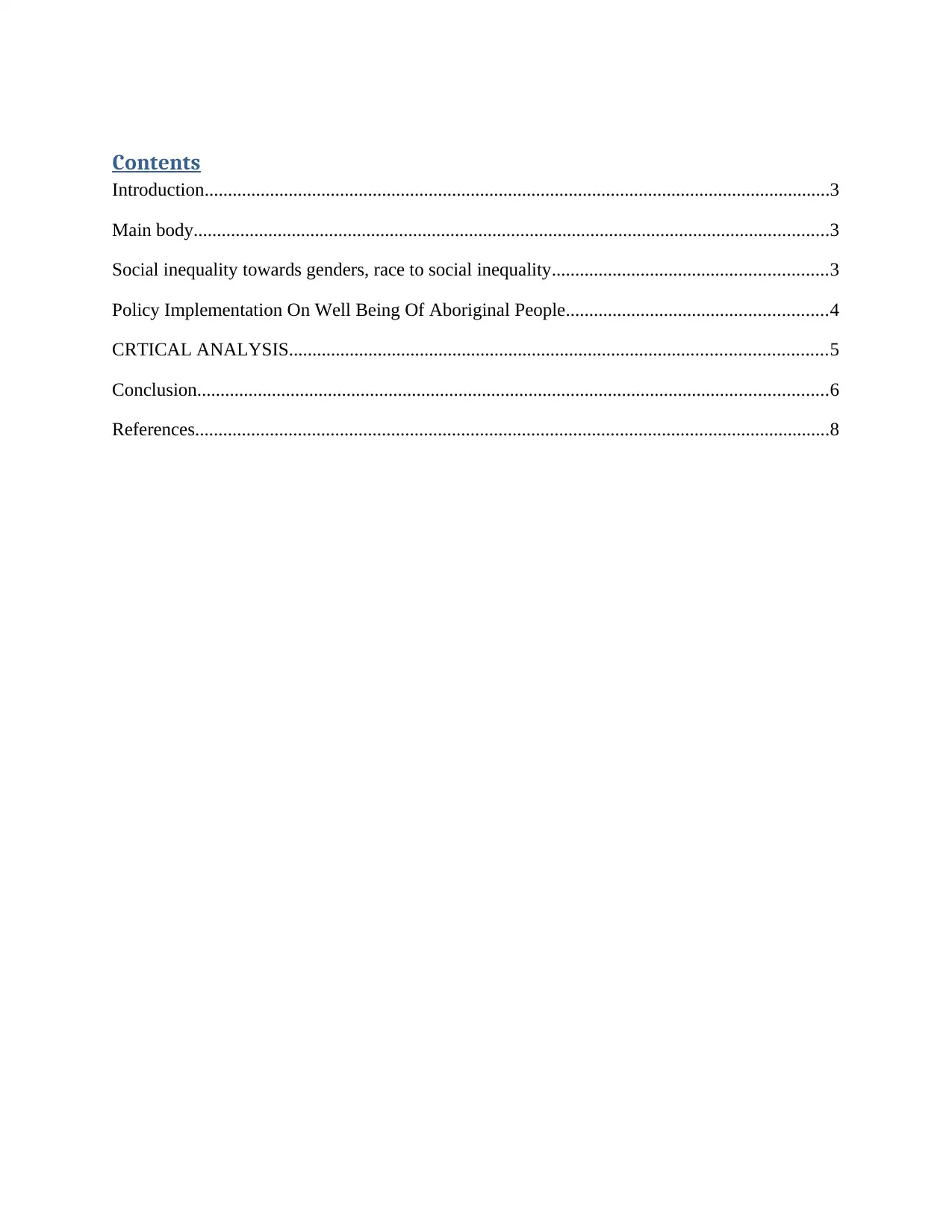
Contents
Introduction......................................................................................................................................3
Main body........................................................................................................................................3
Social inequality towards genders, race to social inequality...........................................................3
Policy Implementation On Well Being Of Aboriginal People........................................................4
CRTICAL ANALYSIS...................................................................................................................5
Conclusion.......................................................................................................................................6
References........................................................................................................................................8
Introduction......................................................................................................................................3
Main body........................................................................................................................................3
Social inequality towards genders, race to social inequality...........................................................3
Policy Implementation On Well Being Of Aboriginal People........................................................4
CRTICAL ANALYSIS...................................................................................................................5
Conclusion.......................................................................................................................................6
References........................................................................................................................................8
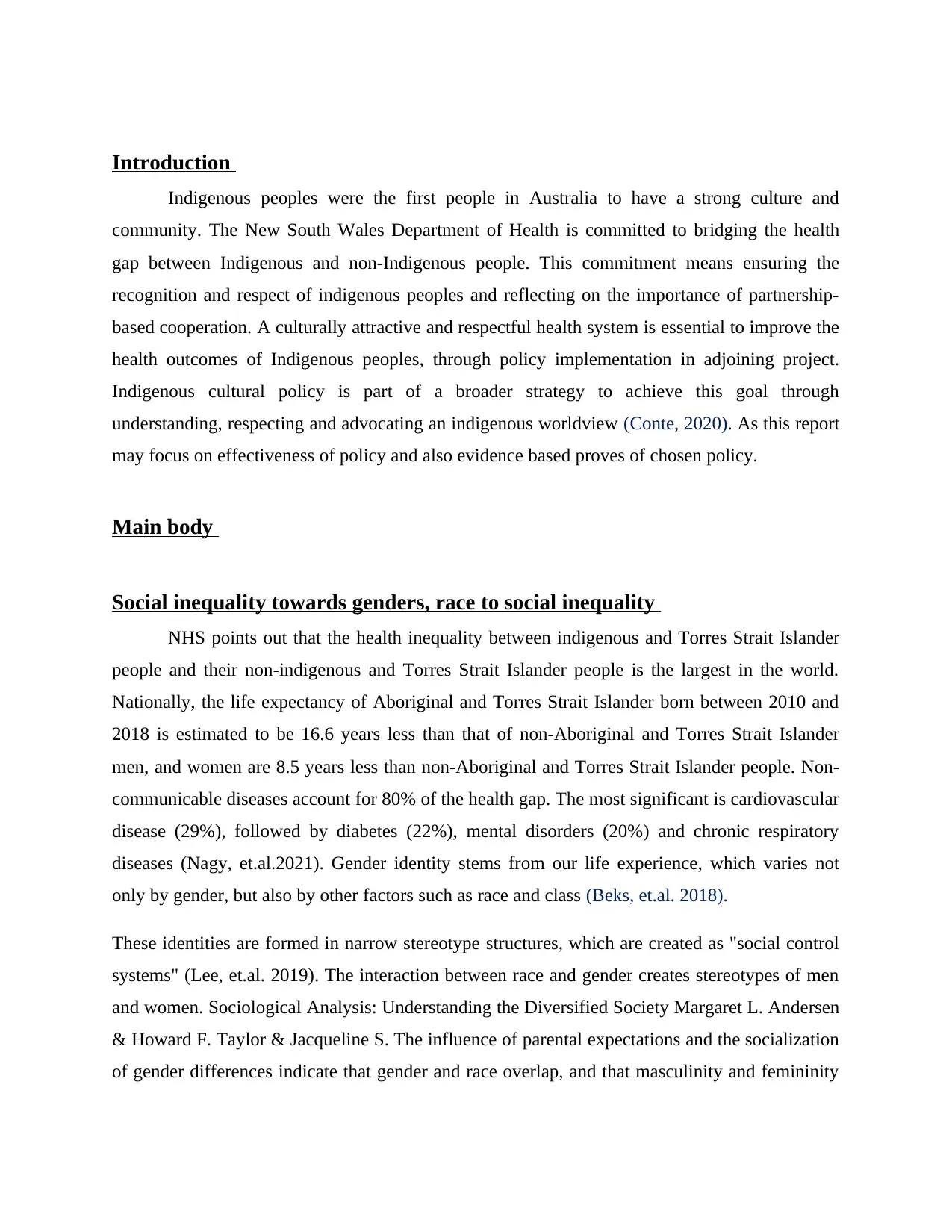
Introduction
Indigenous peoples were the first people in Australia to have a strong culture and
community. The New South Wales Department of Health is committed to bridging the health
gap between Indigenous and non-Indigenous people. This commitment means ensuring the
recognition and respect of indigenous peoples and reflecting on the importance of partnership-
based cooperation. A culturally attractive and respectful health system is essential to improve the
health outcomes of Indigenous peoples, through policy implementation in adjoining project.
Indigenous cultural policy is part of a broader strategy to achieve this goal through
understanding, respecting and advocating an indigenous worldview (Conte, 2020). As this report
may focus on effectiveness of policy and also evidence based proves of chosen policy.
Main body
Social inequality towards genders, race to social inequality
NHS points out that the health inequality between indigenous and Torres Strait Islander
people and their non-indigenous and Torres Strait Islander people is the largest in the world.
Nationally, the life expectancy of Aboriginal and Torres Strait Islander born between 2010 and
2018 is estimated to be 16.6 years less than that of non-Aboriginal and Torres Strait Islander
men, and women are 8.5 years less than non-Aboriginal and Torres Strait Islander people. Non-
communicable diseases account for 80% of the health gap. The most significant is cardiovascular
disease (29%), followed by diabetes (22%), mental disorders (20%) and chronic respiratory
diseases (Nagy, et.al.2021). Gender identity stems from our life experience, which varies not
only by gender, but also by other factors such as race and class (Beks, et.al. 2018).
These identities are formed in narrow stereotype structures, which are created as "social control
systems" (Lee, et.al. 2019). The interaction between race and gender creates stereotypes of men
and women. Sociological Analysis: Understanding the Diversified Society Margaret L. Andersen
& Howard F. Taylor & Jacqueline S. The influence of parental expectations and the socialization
of gender differences indicate that gender and race overlap, and that masculinity and femininity
Indigenous peoples were the first people in Australia to have a strong culture and
community. The New South Wales Department of Health is committed to bridging the health
gap between Indigenous and non-Indigenous people. This commitment means ensuring the
recognition and respect of indigenous peoples and reflecting on the importance of partnership-
based cooperation. A culturally attractive and respectful health system is essential to improve the
health outcomes of Indigenous peoples, through policy implementation in adjoining project.
Indigenous cultural policy is part of a broader strategy to achieve this goal through
understanding, respecting and advocating an indigenous worldview (Conte, 2020). As this report
may focus on effectiveness of policy and also evidence based proves of chosen policy.
Main body
Social inequality towards genders, race to social inequality
NHS points out that the health inequality between indigenous and Torres Strait Islander
people and their non-indigenous and Torres Strait Islander people is the largest in the world.
Nationally, the life expectancy of Aboriginal and Torres Strait Islander born between 2010 and
2018 is estimated to be 16.6 years less than that of non-Aboriginal and Torres Strait Islander
men, and women are 8.5 years less than non-Aboriginal and Torres Strait Islander people. Non-
communicable diseases account for 80% of the health gap. The most significant is cardiovascular
disease (29%), followed by diabetes (22%), mental disorders (20%) and chronic respiratory
diseases (Nagy, et.al.2021). Gender identity stems from our life experience, which varies not
only by gender, but also by other factors such as race and class (Beks, et.al. 2018).
These identities are formed in narrow stereotype structures, which are created as "social control
systems" (Lee, et.al. 2019). The interaction between race and gender creates stereotypes of men
and women. Sociological Analysis: Understanding the Diversified Society Margaret L. Andersen
& Howard F. Taylor & Jacqueline S. The influence of parental expectations and the socialization
of gender differences indicate that gender and race overlap, and that masculinity and femininity
⊘ This is a preview!⊘
Do you want full access?
Subscribe today to unlock all pages.

Trusted by 1+ million students worldwide
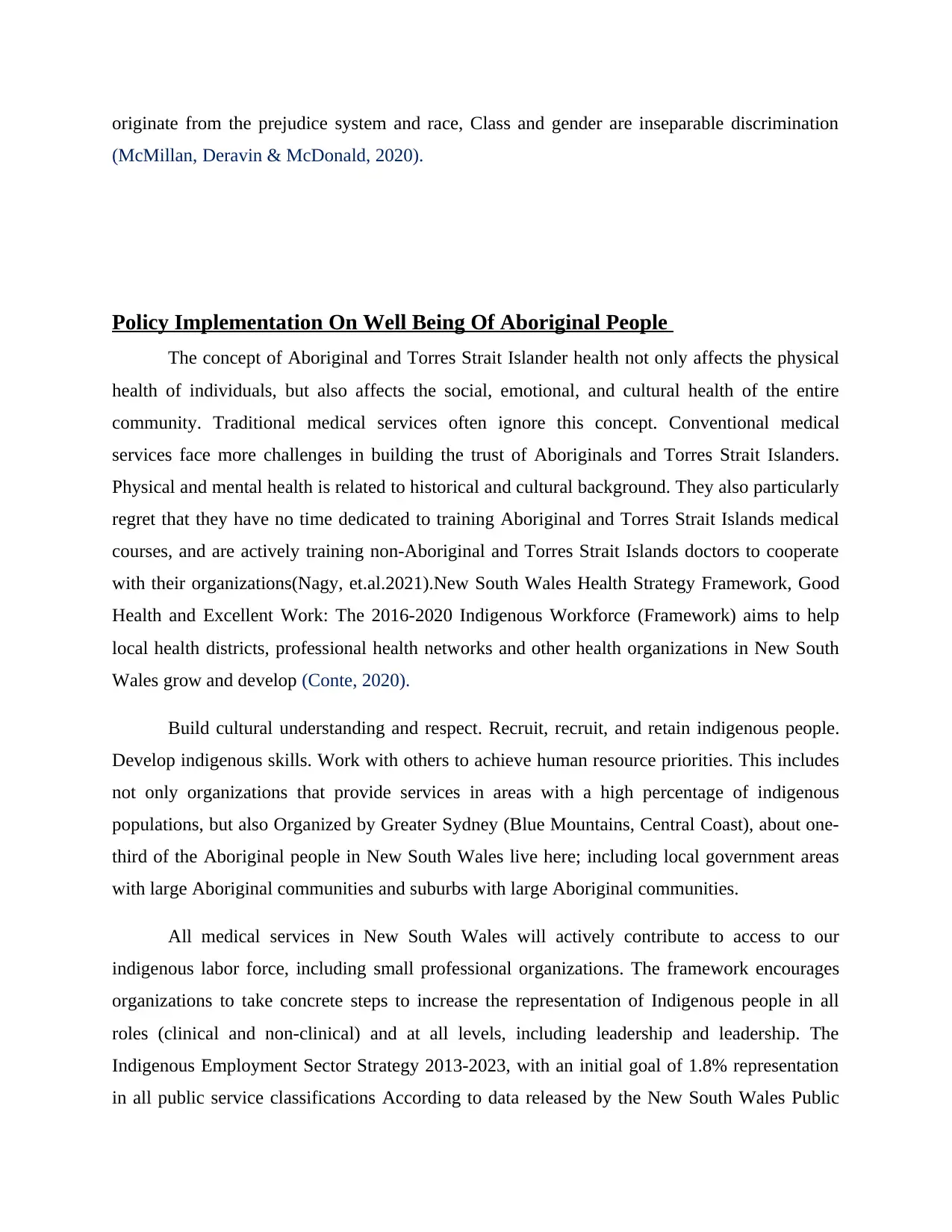
originate from the prejudice system and race, Class and gender are inseparable discrimination
(McMillan, Deravin & McDonald, 2020).
Policy Implementation On Well Being Of Aboriginal People
The concept of Aboriginal and Torres Strait Islander health not only affects the physical
health of individuals, but also affects the social, emotional, and cultural health of the entire
community. Traditional medical services often ignore this concept. Conventional medical
services face more challenges in building the trust of Aboriginals and Torres Strait Islanders.
Physical and mental health is related to historical and cultural background. They also particularly
regret that they have no time dedicated to training Aboriginal and Torres Strait Islands medical
courses, and are actively training non-Aboriginal and Torres Strait Islands doctors to cooperate
with their organizations(Nagy, et.al.2021).New South Wales Health Strategy Framework, Good
Health and Excellent Work: The 2016-2020 Indigenous Workforce (Framework) aims to help
local health districts, professional health networks and other health organizations in New South
Wales grow and develop (Conte, 2020).
Build cultural understanding and respect. Recruit, recruit, and retain indigenous people.
Develop indigenous skills. Work with others to achieve human resource priorities. This includes
not only organizations that provide services in areas with a high percentage of indigenous
populations, but also Organized by Greater Sydney (Blue Mountains, Central Coast), about one-
third of the Aboriginal people in New South Wales live here; including local government areas
with large Aboriginal communities and suburbs with large Aboriginal communities.
All medical services in New South Wales will actively contribute to access to our
indigenous labor force, including small professional organizations. The framework encourages
organizations to take concrete steps to increase the representation of Indigenous people in all
roles (clinical and non-clinical) and at all levels, including leadership and leadership. The
Indigenous Employment Sector Strategy 2013-2023, with an initial goal of 1.8% representation
in all public service classifications According to data released by the New South Wales Public
(McMillan, Deravin & McDonald, 2020).
Policy Implementation On Well Being Of Aboriginal People
The concept of Aboriginal and Torres Strait Islander health not only affects the physical
health of individuals, but also affects the social, emotional, and cultural health of the entire
community. Traditional medical services often ignore this concept. Conventional medical
services face more challenges in building the trust of Aboriginals and Torres Strait Islanders.
Physical and mental health is related to historical and cultural background. They also particularly
regret that they have no time dedicated to training Aboriginal and Torres Strait Islands medical
courses, and are actively training non-Aboriginal and Torres Strait Islands doctors to cooperate
with their organizations(Nagy, et.al.2021).New South Wales Health Strategy Framework, Good
Health and Excellent Work: The 2016-2020 Indigenous Workforce (Framework) aims to help
local health districts, professional health networks and other health organizations in New South
Wales grow and develop (Conte, 2020).
Build cultural understanding and respect. Recruit, recruit, and retain indigenous people.
Develop indigenous skills. Work with others to achieve human resource priorities. This includes
not only organizations that provide services in areas with a high percentage of indigenous
populations, but also Organized by Greater Sydney (Blue Mountains, Central Coast), about one-
third of the Aboriginal people in New South Wales live here; including local government areas
with large Aboriginal communities and suburbs with large Aboriginal communities.
All medical services in New South Wales will actively contribute to access to our
indigenous labor force, including small professional organizations. The framework encourages
organizations to take concrete steps to increase the representation of Indigenous people in all
roles (clinical and non-clinical) and at all levels, including leadership and leadership. The
Indigenous Employment Sector Strategy 2013-2023, with an initial goal of 1.8% representation
in all public service classifications According to data released by the New South Wales Public
Paraphrase This Document
Need a fresh take? Get an instant paraphrase of this document with our AI Paraphraser
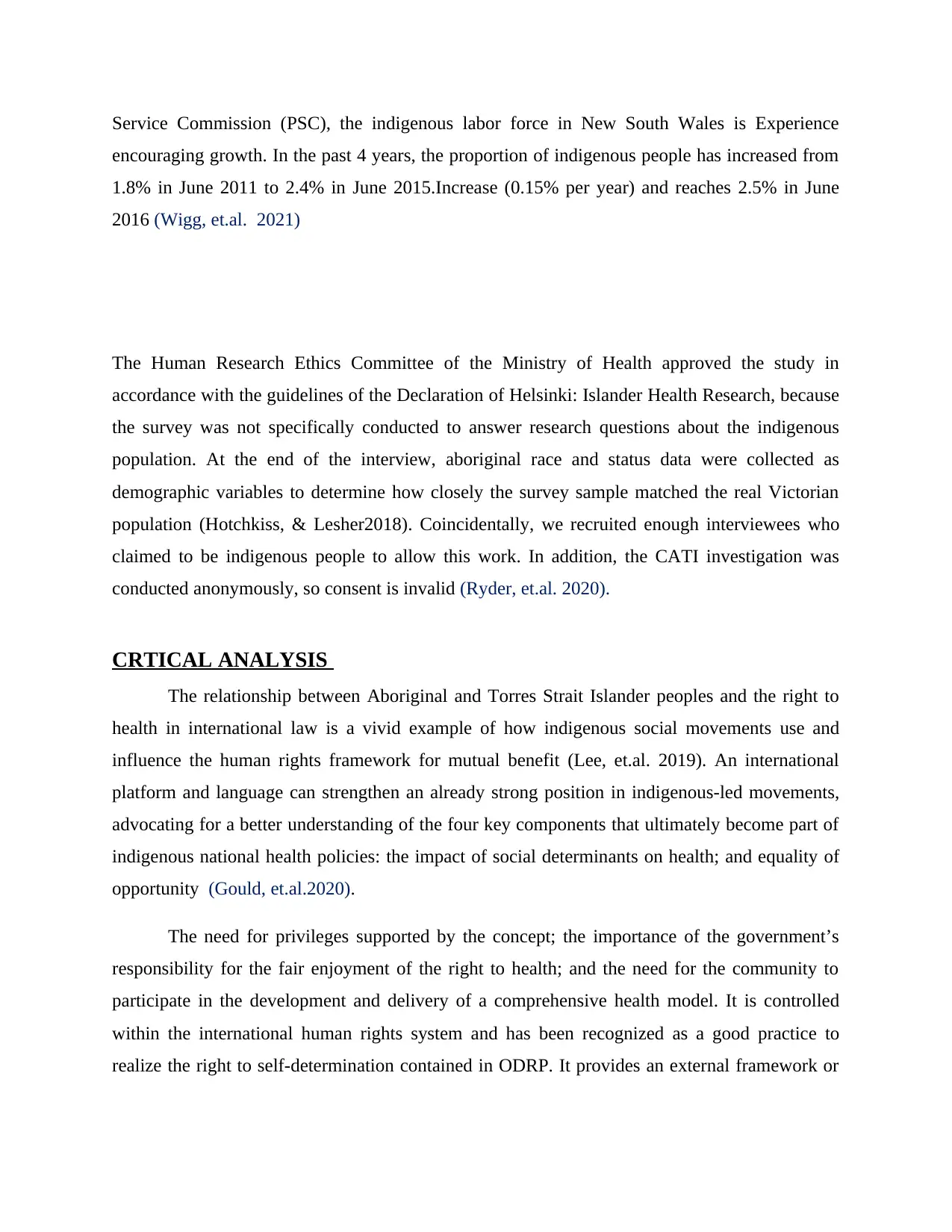
Service Commission (PSC), the indigenous labor force in New South Wales is Experience
encouraging growth. In the past 4 years, the proportion of indigenous people has increased from
1.8% in June 2011 to 2.4% in June 2015.Increase (0.15% per year) and reaches 2.5% in June
2016 (Wigg, et.al. 2021)
The Human Research Ethics Committee of the Ministry of Health approved the study in
accordance with the guidelines of the Declaration of Helsinki: Islander Health Research, because
the survey was not specifically conducted to answer research questions about the indigenous
population. At the end of the interview, aboriginal race and status data were collected as
demographic variables to determine how closely the survey sample matched the real Victorian
population (Hotchkiss, & Lesher2018). Coincidentally, we recruited enough interviewees who
claimed to be indigenous people to allow this work. In addition, the CATI investigation was
conducted anonymously, so consent is invalid (Ryder, et.al. 2020).
CRTICAL ANALYSIS
The relationship between Aboriginal and Torres Strait Islander peoples and the right to
health in international law is a vivid example of how indigenous social movements use and
influence the human rights framework for mutual benefit (Lee, et.al. 2019). An international
platform and language can strengthen an already strong position in indigenous-led movements,
advocating for a better understanding of the four key components that ultimately become part of
indigenous national health policies: the impact of social determinants on health; and equality of
opportunity (Gould, et.al.2020).
The need for privileges supported by the concept; the importance of the government’s
responsibility for the fair enjoyment of the right to health; and the need for the community to
participate in the development and delivery of a comprehensive health model. It is controlled
within the international human rights system and has been recognized as a good practice to
realize the right to self-determination contained in ODRP. It provides an external framework or
encouraging growth. In the past 4 years, the proportion of indigenous people has increased from
1.8% in June 2011 to 2.4% in June 2015.Increase (0.15% per year) and reaches 2.5% in June
2016 (Wigg, et.al. 2021)
The Human Research Ethics Committee of the Ministry of Health approved the study in
accordance with the guidelines of the Declaration of Helsinki: Islander Health Research, because
the survey was not specifically conducted to answer research questions about the indigenous
population. At the end of the interview, aboriginal race and status data were collected as
demographic variables to determine how closely the survey sample matched the real Victorian
population (Hotchkiss, & Lesher2018). Coincidentally, we recruited enough interviewees who
claimed to be indigenous people to allow this work. In addition, the CATI investigation was
conducted anonymously, so consent is invalid (Ryder, et.al. 2020).
CRTICAL ANALYSIS
The relationship between Aboriginal and Torres Strait Islander peoples and the right to
health in international law is a vivid example of how indigenous social movements use and
influence the human rights framework for mutual benefit (Lee, et.al. 2019). An international
platform and language can strengthen an already strong position in indigenous-led movements,
advocating for a better understanding of the four key components that ultimately become part of
indigenous national health policies: the impact of social determinants on health; and equality of
opportunity (Gould, et.al.2020).
The need for privileges supported by the concept; the importance of the government’s
responsibility for the fair enjoyment of the right to health; and the need for the community to
participate in the development and delivery of a comprehensive health model. It is controlled
within the international human rights system and has been recognized as a good practice to
realize the right to self-determination contained in ODRP. It provides an external framework or

toolbox for indigenous peoples to support their own initiatives and continue to influence state
behavior (Grus, et.al.2017).
While the indigenous peoples of Australia strive to recognize the special rights in
international human rights law, they also use the existing national human rights system to
advance local issues. These rights are adopted to strengthen support for human rights. Civil,
political and territorial rights as well as campaigns and special measures applied to improve the
health of indigenous peoples.
As a human right applicable to all people, the right to health in international law provides many
principles that resonate with indigenous peoples. Torres Street. Despite the slow response of the
government, the island influences the methods of change. Although the right to health was
mentioned in early documents of the World Health Organization (WHO), it was not until this
decade of international public health lectures that the positive connection between health and
human rights was spread. The link between indigenous health and rights-based frameworks
became apparent in indigenous programs run by cooperatives and health services controlled by
indigenous communities in the early 1970s and in the 1989 Indigenous Strategic National Health
Survey (Smith, et.al.2021).
In 1947, the WHO Constitution was first formulated internationally, and health was
defined as "a state of complete physical, mental, and social health, not just the absence of disease
or pain". The WHO has recognized that “enjoying the highest possible standard of health is a
basic right for everyone, regardless of race, religion, political beliefs, economic or social status.”
“By broadly describing health as more than just Physical health, WHO has recognized the core
impact of social determinants on human health and well-being (Boden, Ward & Wilson, 2018)
and noted that health is a fundamental right, and it attaches great importance to health in the
international context of the right to an adequate standard of living under Article 25 (Boffa,
Tilton, & Ah 2018).
Accepting the World Health Organization for instance, ICESCR perceives in Article 12
that "everybody is qualified for the most elevated achievable degree of physical and emotional
wellness", which records a portion of the wellbeing related legitimate commitments of
behavior (Grus, et.al.2017).
While the indigenous peoples of Australia strive to recognize the special rights in
international human rights law, they also use the existing national human rights system to
advance local issues. These rights are adopted to strengthen support for human rights. Civil,
political and territorial rights as well as campaigns and special measures applied to improve the
health of indigenous peoples.
As a human right applicable to all people, the right to health in international law provides many
principles that resonate with indigenous peoples. Torres Street. Despite the slow response of the
government, the island influences the methods of change. Although the right to health was
mentioned in early documents of the World Health Organization (WHO), it was not until this
decade of international public health lectures that the positive connection between health and
human rights was spread. The link between indigenous health and rights-based frameworks
became apparent in indigenous programs run by cooperatives and health services controlled by
indigenous communities in the early 1970s and in the 1989 Indigenous Strategic National Health
Survey (Smith, et.al.2021).
In 1947, the WHO Constitution was first formulated internationally, and health was
defined as "a state of complete physical, mental, and social health, not just the absence of disease
or pain". The WHO has recognized that “enjoying the highest possible standard of health is a
basic right for everyone, regardless of race, religion, political beliefs, economic or social status.”
“By broadly describing health as more than just Physical health, WHO has recognized the core
impact of social determinants on human health and well-being (Boden, Ward & Wilson, 2018)
and noted that health is a fundamental right, and it attaches great importance to health in the
international context of the right to an adequate standard of living under Article 25 (Boffa,
Tilton, & Ah 2018).
Accepting the World Health Organization for instance, ICESCR perceives in Article 12
that "everybody is qualified for the most elevated achievable degree of physical and emotional
wellness", which records a portion of the wellbeing related legitimate commitments of
⊘ This is a preview!⊘
Do you want full access?
Subscribe today to unlock all pages.

Trusted by 1+ million students worldwide

confirming nations (Ryder, et.al. 2020). The WHO and the UN Human Rights Council (when the
Commission on Human Rights) have given growing thought aside to prosperity, and normal
freedoms settlement bodies have accepted general comments or general ideas on the right to
prosperity and prosperity related issues. In 2002, the UN Special Rapporteur on the right of
everyone to the most vital attainable standard of physical and mental wellbeing was assigned to
clarify the possibility of the right and how it will in general be cultivated. The right has also been
declared and stretched out as time goes on in its application to discrete social affairs guaranteed
by other fundamental opportunities bargains (Kearns, et.al. 2021).
Conclusion
As per my analysis it has been concluded that The UNDRIP additionally unequivocally
accentuates the significance of social determinants in improving wellbeing, and the right of
Indigenous people groups to take a functioning part in dynamic cycles in issue that influence
their privileges just as directing those projects through their own establishments. What can be
seen from this authentic outline is that wellbeing gives a significant site of blend where the
philosophical ways to deal with wellbeing advocated by the Indigenous people group supplement
drives in the global field and the other way around. Megan Davis, who filled in as Australia's
master part on the UN Permanent Forum on Indigenous Peoples, asserts that contribution from
the National Aboriginal Community Controlled Health Organization has had "an undeniable
distinction to the wellbeing order" of the Forum, particularly in their backing for local area
control.
Commission on Human Rights) have given growing thought aside to prosperity, and normal
freedoms settlement bodies have accepted general comments or general ideas on the right to
prosperity and prosperity related issues. In 2002, the UN Special Rapporteur on the right of
everyone to the most vital attainable standard of physical and mental wellbeing was assigned to
clarify the possibility of the right and how it will in general be cultivated. The right has also been
declared and stretched out as time goes on in its application to discrete social affairs guaranteed
by other fundamental opportunities bargains (Kearns, et.al. 2021).
Conclusion
As per my analysis it has been concluded that The UNDRIP additionally unequivocally
accentuates the significance of social determinants in improving wellbeing, and the right of
Indigenous people groups to take a functioning part in dynamic cycles in issue that influence
their privileges just as directing those projects through their own establishments. What can be
seen from this authentic outline is that wellbeing gives a significant site of blend where the
philosophical ways to deal with wellbeing advocated by the Indigenous people group supplement
drives in the global field and the other way around. Megan Davis, who filled in as Australia's
master part on the UN Permanent Forum on Indigenous Peoples, asserts that contribution from
the National Aboriginal Community Controlled Health Organization has had "an undeniable
distinction to the wellbeing order" of the Forum, particularly in their backing for local area
control.
Paraphrase This Document
Need a fresh take? Get an instant paraphrase of this document with our AI Paraphraser

References
Book and journals
Ryder, C., Mackean, T., Hunter, K., Towers, K., Rogers, K., Holland, A. J., & Ivers, R. (2020).
Factors contributing to longer length of stay in Aboriginal and Torres Strait Islander children
hospitalised for burn injury. Injury epidemiology, 7(1), 1-11.
Boffa, J., Tilton, E., & Ah Chee, D. (2018). Preventing alcohol-related harm in Aboriginal and
Torres Strait Islander communities:'The experience of an Aboriginal Community Controlled
Health Service in Central Australia'. Australian journal of general practice, 47(12), 851-854.
Kearns, T., Diaz, A., Whop, L. J., Moore, S. P., Condon, J. R., Andrews, R. M., ... &
Williamson, D. (2021). Investigating inequities in cardiovascular care and outcomes for
Queensland Aboriginal and Torres Strait Islander people: protocol for a hospital-based
retrospective cohort data linkage project. BMJ open, 11(3), e043304.
Ryder, C., Mackean, T., Coombs, J., Williams, H., Hunter, K., Holland, A. J., & Ivers, R. Q.
(2020). Indigenous research methodology–weaving a research interface. International Journal
of Social Research Methodology, 23(3), 255-267.
Smith, J. A., Wells, L., Gelbart, L., & Lawson, T. (2021). Beyond COVID‐19: Consumers call
for greater focus on health equity. Health Promotion Journal of Australia, 32(1), 3.
Gould, G. S., Holder, C., Oldmeadow, C., & Gruppetta, M. (2020). Supports Used by Aboriginal
and Torres Strait Islander Women for Their Health, including Smoking Cessation, and a
Baby’s Health: A Cross-Sectional Survey in New South Wales, Australia. International
journal of environmental research and public health, 17(21), 7766.
McMillan, F., Deravin, L., & McDonald, G. (2020). Aboriginal and Torres Strait Islander health.
In Nursing in Australia (pp. 53-64). Routledge.
Book and journals
Ryder, C., Mackean, T., Hunter, K., Towers, K., Rogers, K., Holland, A. J., & Ivers, R. (2020).
Factors contributing to longer length of stay in Aboriginal and Torres Strait Islander children
hospitalised for burn injury. Injury epidemiology, 7(1), 1-11.
Boffa, J., Tilton, E., & Ah Chee, D. (2018). Preventing alcohol-related harm in Aboriginal and
Torres Strait Islander communities:'The experience of an Aboriginal Community Controlled
Health Service in Central Australia'. Australian journal of general practice, 47(12), 851-854.
Kearns, T., Diaz, A., Whop, L. J., Moore, S. P., Condon, J. R., Andrews, R. M., ... &
Williamson, D. (2021). Investigating inequities in cardiovascular care and outcomes for
Queensland Aboriginal and Torres Strait Islander people: protocol for a hospital-based
retrospective cohort data linkage project. BMJ open, 11(3), e043304.
Ryder, C., Mackean, T., Coombs, J., Williams, H., Hunter, K., Holland, A. J., & Ivers, R. Q.
(2020). Indigenous research methodology–weaving a research interface. International Journal
of Social Research Methodology, 23(3), 255-267.
Smith, J. A., Wells, L., Gelbart, L., & Lawson, T. (2021). Beyond COVID‐19: Consumers call
for greater focus on health equity. Health Promotion Journal of Australia, 32(1), 3.
Gould, G. S., Holder, C., Oldmeadow, C., & Gruppetta, M. (2020). Supports Used by Aboriginal
and Torres Strait Islander Women for Their Health, including Smoking Cessation, and a
Baby’s Health: A Cross-Sectional Survey in New South Wales, Australia. International
journal of environmental research and public health, 17(21), 7766.
McMillan, F., Deravin, L., & McDonald, G. (2020). Aboriginal and Torres Strait Islander health.
In Nursing in Australia (pp. 53-64). Routledge.
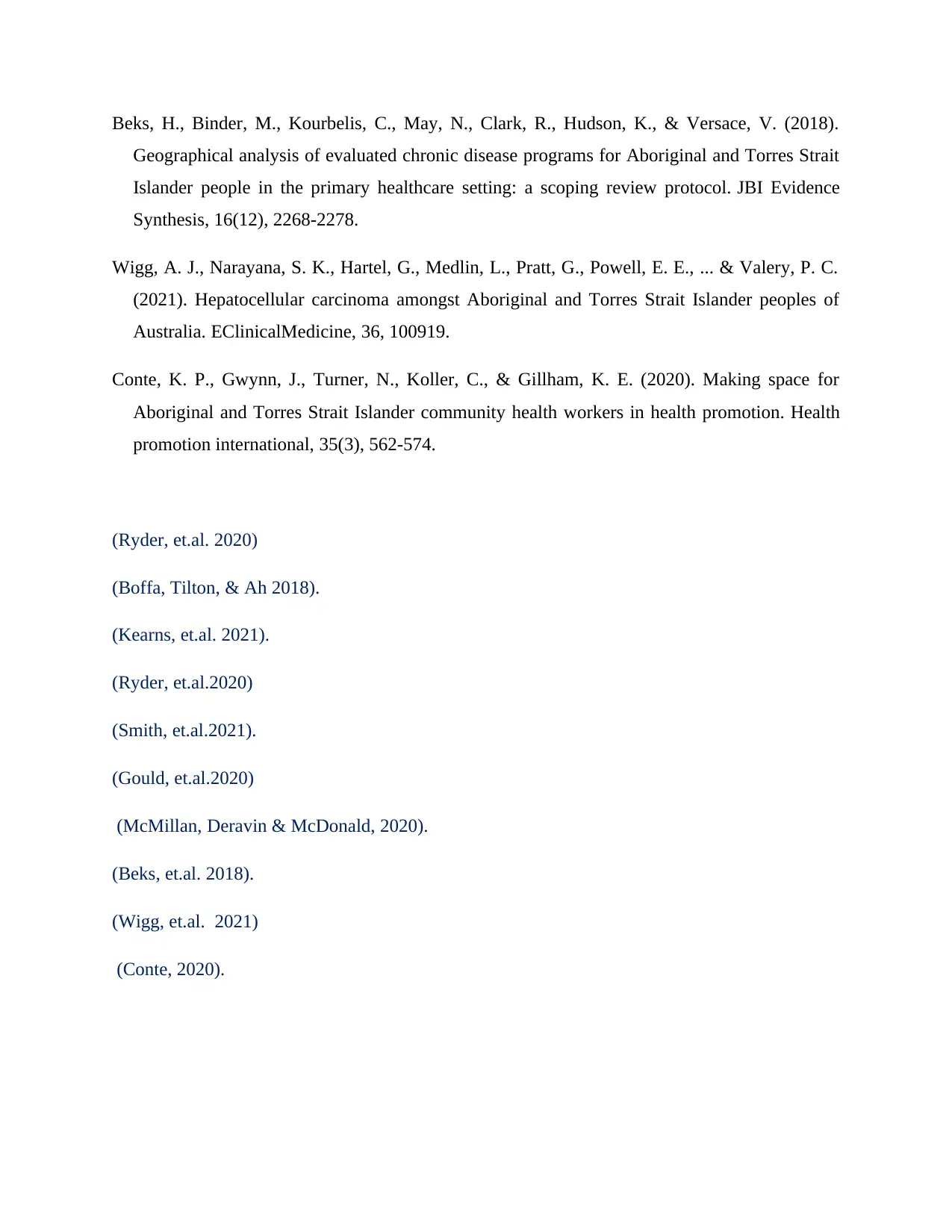
Beks, H., Binder, M., Kourbelis, C., May, N., Clark, R., Hudson, K., & Versace, V. (2018).
Geographical analysis of evaluated chronic disease programs for Aboriginal and Torres Strait
Islander people in the primary healthcare setting: a scoping review protocol. JBI Evidence
Synthesis, 16(12), 2268-2278.
Wigg, A. J., Narayana, S. K., Hartel, G., Medlin, L., Pratt, G., Powell, E. E., ... & Valery, P. C.
(2021). Hepatocellular carcinoma amongst Aboriginal and Torres Strait Islander peoples of
Australia. EClinicalMedicine, 36, 100919.
Conte, K. P., Gwynn, J., Turner, N., Koller, C., & Gillham, K. E. (2020). Making space for
Aboriginal and Torres Strait Islander community health workers in health promotion. Health
promotion international, 35(3), 562-574.
(Ryder, et.al. 2020)
(Boffa, Tilton, & Ah 2018).
(Kearns, et.al. 2021).
(Ryder, et.al.2020)
(Smith, et.al.2021).
(Gould, et.al.2020)
(McMillan, Deravin & McDonald, 2020).
(Beks, et.al. 2018).
(Wigg, et.al. 2021)
(Conte, 2020).
Geographical analysis of evaluated chronic disease programs for Aboriginal and Torres Strait
Islander people in the primary healthcare setting: a scoping review protocol. JBI Evidence
Synthesis, 16(12), 2268-2278.
Wigg, A. J., Narayana, S. K., Hartel, G., Medlin, L., Pratt, G., Powell, E. E., ... & Valery, P. C.
(2021). Hepatocellular carcinoma amongst Aboriginal and Torres Strait Islander peoples of
Australia. EClinicalMedicine, 36, 100919.
Conte, K. P., Gwynn, J., Turner, N., Koller, C., & Gillham, K. E. (2020). Making space for
Aboriginal and Torres Strait Islander community health workers in health promotion. Health
promotion international, 35(3), 562-574.
(Ryder, et.al. 2020)
(Boffa, Tilton, & Ah 2018).
(Kearns, et.al. 2021).
(Ryder, et.al.2020)
(Smith, et.al.2021).
(Gould, et.al.2020)
(McMillan, Deravin & McDonald, 2020).
(Beks, et.al. 2018).
(Wigg, et.al. 2021)
(Conte, 2020).
⊘ This is a preview!⊘
Do you want full access?
Subscribe today to unlock all pages.

Trusted by 1+ million students worldwide
1 out of 9
Related Documents
Your All-in-One AI-Powered Toolkit for Academic Success.
+13062052269
info@desklib.com
Available 24*7 on WhatsApp / Email
![[object Object]](/_next/static/media/star-bottom.7253800d.svg)
Unlock your academic potential
Copyright © 2020–2025 A2Z Services. All Rights Reserved. Developed and managed by ZUCOL.




